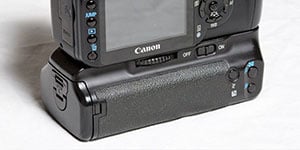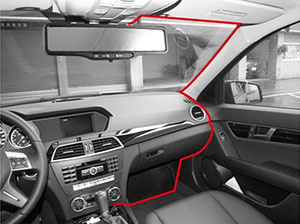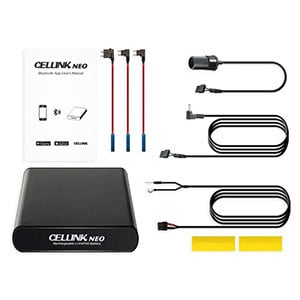Battery powered dashcams, fiction or reality?
Battery powered dashcams, are they real or only a figment of our imagination? Dashcams come in all shapes and sizes. With one, two or even three cameras, GPS, Wifi, Bluetooth, etc. So you wouldn't think there is much more to wish for. Still: A battery powered dashcam.
Dashcam on battery
We hear it more and more often: "I'm looking for a battery powered dashcam" and "Is a dashcam rechargeable or does a rechargeable dashcam exist?" There seems to be a lot of demand for battery powered dashcams. It also sounds very convenient; you charge the dashcam at home for a few hours and when you go driving you place the dashcam in the car and it films until the battery runs out. You then no longer need a power supply and cables in the car and it also protects your car's battery from draining.
Built-in batteries small
 Fact is that while most dashcams have a built-in battery, they are generally very small. In many other types of video cameras and cameras, there is often a battery or battery of at least 1000mAh. You need these because you will often use the camera in a place where there is no power supply. Smartphones sometimes even have batteries of 2000mAh or more. In dashcams, the battery or battery capacity often does not exceed 300mAh, enough to film for maybe 10 minutes.
Fact is that while most dashcams have a built-in battery, they are generally very small. In many other types of video cameras and cameras, there is often a battery or battery of at least 1000mAh. You need these because you will often use the camera in a place where there is no power supply. Smartphones sometimes even have batteries of 2000mAh or more. In dashcams, the battery or battery capacity often does not exceed 300mAh, enough to film for maybe 10 minutes.
For emergencies
So what is the dashcam battery for? The main reason there is a battery in a dashcam is for safety. This is because the battery ensures that the last video can still be saved in the event of a sudden power failure, such as an accident. Would a dashcam have no battery or battery then the dashcam would immediately shut down and the last (usually crucial) video would not be saved to the SD card.
Why no larger batteries?
Smartphones and other cameras thus often have a larger battery. So why isn't there a larger battery or battery in a dashcam? There are a few reasons for this:
Durability
Normal batteries and accumulators work best when they are fully charged and then fully drained. It is not good for a battery to only half charge and drain it, the capacity will deteriorate quickly. In practice, a dashcam is connected almost continuously to the cigarette power supply in the car. If there would be a large (expensive) battery in it, it would not last long anyway, a real shame. Hence, many manufacturers opt for a smaller cheap battery.
Safety
A battery does not withstand high and low temperatures very well, much less fluctuations in them. A car dashboard can quickly become about 100˚C on a hot day, disastrous for a battery and even very dangerous. Indeed, at too high temperatures, a battery or battery can leak or, in the worst case, explode.
Unnecessary
Maybe the most obvious reason dashcams don't have a large battery is that you use them in the car. In the car, you have plenty of ways to power the dashcam. Your car's battery is very large and is continuously charged so you will never run out of power for the dashcam.
Battery vs. Super capacitor
 Many dashcams today no longer have a built-in battery but a so-called super capacitor. Dashcams with a super capacitor are a lot more durable than those with a battery and can also withstand more extreme temperatures. A super capacitor creates a disturbing static charge between two plates, whereas a battery generates voltage through chemical processes. Super capacitors are a bit more expensive than batteries which is why you see them mostly in dashcams in a higher price category. However, the lifespan of dashcams with a super capacitor is a lot longer than dashcams with a battery.
Many dashcams today no longer have a built-in battery but a so-called super capacitor. Dashcams with a super capacitor are a lot more durable than those with a battery and can also withstand more extreme temperatures. A super capacitor creates a disturbing static charge between two plates, whereas a battery generates voltage through chemical processes. Super capacitors are a bit more expensive than batteries which is why you see them mostly in dashcams in a higher price category. However, the lifespan of dashcams with a super capacitor is a lot longer than dashcams with a battery.
A "disadvantage" is that a super capacitor generates much less current than a battery, so a dashcam with super capacitor actually shuts down almost immediately when the power is interrupted. Dashcams with a Super capacitor can therefore not be used at all without being connected to the power supply in the car or an external battery pack, where dashcams with a small battery can still be used for a few minutes.
How to do it?
So you can't charge a dashcam. So how do you use it? There are basically three options:
1. Cigarette power The simplest way to power your dashcam is to connect it to the cigarette power supply in the car. Each dashcam comes with a cigarette power supply with a long cable that you can easily tuck away. This way, the dashcam will turn on and start recording when you start the car and stop again when you turn off the car. The condition for this is that your car does not supply power through the cigarette power supply when the ignition is off. In that case, you also don't have to worry about it draining the car's battery because it is only on when you are driving.
The simplest way to power your dashcam is to connect it to the cigarette power supply in the car. Each dashcam comes with a cigarette power supply with a long cable that you can easily tuck away. This way, the dashcam will turn on and start recording when you start the car and stop again when you turn off the car. The condition for this is that your car does not supply power through the cigarette power supply when the ignition is off. In that case, you also don't have to worry about it draining the car's battery because it is only on when you are driving.
There are some disadvantages to using cigarette power. If your car does provide power with the ignition turned off, the camera will always stay on and you will have to turn it on and off manually. Also, the parking mode will not work because the dashcam will not receive power when the car is parked. In these cases, it is recommended to connect it with a continuous power supply.
2. Continuous power supply Connecting the dashcam with a continuous power supply is a good idea when you want to use the dashcam in parking mode or when you don't want to use the cigarette power supply for some other reason. A continuous power supply is a separate power supply that you connect to the car battery, preferably via fuse box. By connecting your dashcam in this way, it can be used even with the ignition turned off and the dashcam can also record in parking mode. You can also use the continuous power supply when you want the dashcam to turn on and off with the ignition but the cigarette power supply in your car provides continuous power. You simply connect the power supply to a fuse that does not provide any current when the ignition is turned off.
Connecting the dashcam with a continuous power supply is a good idea when you want to use the dashcam in parking mode or when you don't want to use the cigarette power supply for some other reason. A continuous power supply is a separate power supply that you connect to the car battery, preferably via fuse box. By connecting your dashcam in this way, it can be used even with the ignition turned off and the dashcam can also record in parking mode. You can also use the continuous power supply when you want the dashcam to turn on and off with the ignition but the cigarette power supply in your car provides continuous power. You simply connect the power supply to a fuse that does not provide any current when the ignition is turned off.
There are different continuous power supplies depending on the type of dashcam. Standard '2-wire' continuous power supplies have two connections, a + and -. You connect the + to a continuous or switched fuse and the - to the ground of the car. There are also '3-wire' power supplies, which connect to both a continuous and switched fuse and to the car's ground. Dashcams with 3-wire power supplies have the option to automatically switch in and out of park mode when you turn the ignition on and off. Note that not all dashcams support this option.
3. Battery pack If you prefer not to connect the dashcam to a power point in the car, you can use the dashcam with a battery pack. You can basically use a standard battery pack or power bank that you use, for example, for charging your phone and other equipment. In that case, we recommend opting for a Powerbank from Anker. A better option is to opt for a Cellink power bank. These Battery packs are designed specifically for using dashcams in the car.
If you prefer not to connect the dashcam to a power point in the car, you can use the dashcam with a battery pack. You can basically use a standard battery pack or power bank that you use, for example, for charging your phone and other equipment. In that case, we recommend opting for a Powerbank from Anker. A better option is to opt for a Cellink power bank. These Battery packs are designed specifically for using dashcams in the car.
Cellink Neo 5 4500mAh
The Cellink Neo 5 'Plug&Play' battery pack is the ideal accessory to power your dashcam without taxing the car battery. It then provides up to about 15 hours of power to the dashcam when the car is turned off. Dashcams with a visual parking mode (which automatically turn on after the car is stopped for a few minutes) can thus easily be used with the Cellink Neo 5 battery pack.
Cellink Neo 8+ 7500mAh
The largest battery pack from Cellink is the Neo 8+. In terms of features, it is similar to the Neo 6, however, it has a larger capacity of 7500mAh so you can use it even longer.






